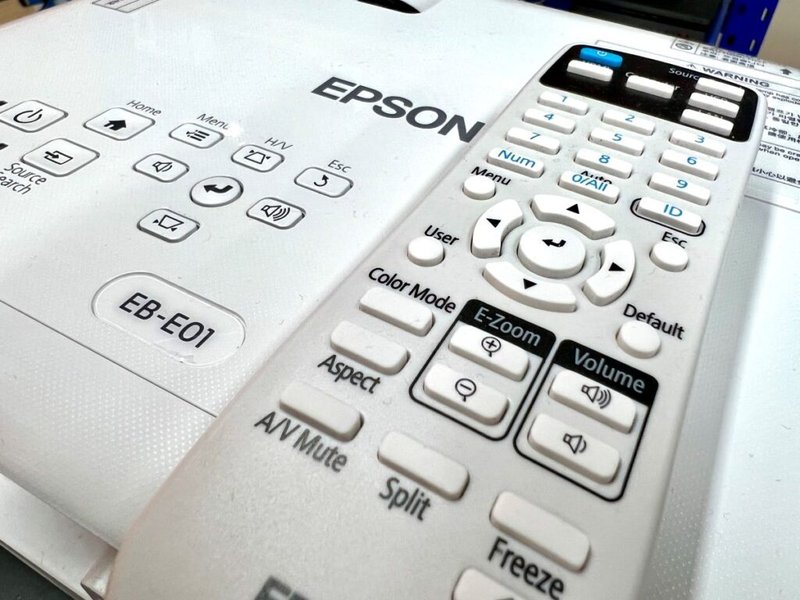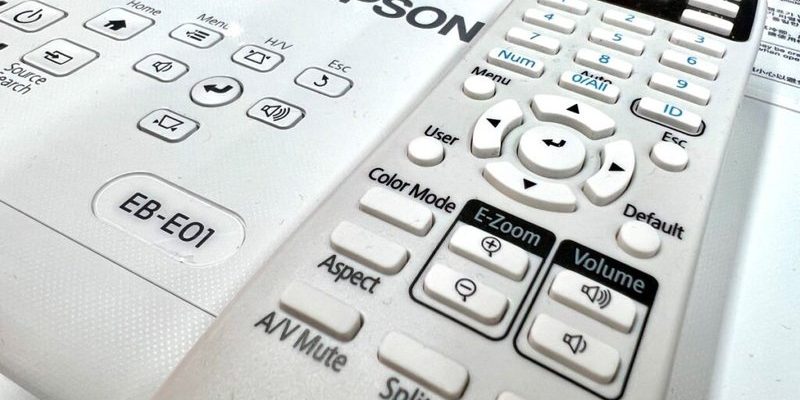
So, here’s the scoop: Epson projector remotes are (usually) sturdy little devices, but every now and then, they just stop cooperating. Maybe the buttons seem dead, or you’re frantically pressing “Power” like it’s a video game cheat code—nothing. At first, it feels like the projector itself is broken, but most of the time, it’s just the remote waving a tiny white flag for help. Whether you’re using one of those slim, classic Epson remotes or a fancier universal model, figuring out why it’s not working doesn’t have to leave you in the dark.
Common Reasons Your Epson Projector Remote Stops Responding
Before you start overthinking things, let’s slow down and talk through the basics. Most of the time, remote issues aren’t mysterious—they’re just annoyingly simple. The battery? Sure, it sounds obvious, but dead or weak batteries account for a huge chunk of remote issues. If you haven’t swapped out those little AAAs (or coin cell battery, depending on your model) in a while, that’s honestly the first place to start.
Another classic culprit is the line-of-sight issue. Your Epson projector remote isn’t magic—there’s an invisible beam (infrared, to get nerdy) that needs to travel straight from the remote to your projector’s receiver. If there’s something in the way—like a plant, a stack of books, your cat’s tail—you’ll get nothing but frustration. And let’s not forget about dirty remotes or sensors. Epson projector sensors can get dusty, and that thin layer of grime is enough to block the signal. Sometimes, all it takes is a quick wipe with a soft cloth to bring everything back to life.
Sometimes, the issue isn’t physical at all. Remotes can lose sync or need to be paired again, especially if you’ve played around with settings, used a universal remote, or hit a weird combination of buttons by accident. That’s when you might need to reset or re-code your remote. The good news? Most fixes are easier than you think.
Checking and Replacing the Batteries
Honestly, it’s wild how often the solution is just fresh batteries. I can’t count the times I’ve gone down a troubleshooting rabbit hole only to realize the remote simply needed a swap. If your Epson projector remote isn’t working, flip it over, open the battery cover, and pop out those old batteries.
- Always check for battery corrosion—a white powdery gunk is a dead giveaway. If you see any, grab a cotton swab, dip it in a bit of vinegar, and clean it carefully (after removing the batteries, of course).
- Make sure to put the new batteries in the right way. It sounds silly, but even adults mess this up more than we’d like to admit. Look for the plus (+) and minus (-) signs in the battery compartment.
- Use fresh, high-quality batteries. Cheap ones from the bottom of the drawer might not last, and rechargeable ones don’t always play nicely.
Once the new batteries are in, test the remote. Still nothing? Don’t worry—we’re just getting started. Sometimes you need to press several buttons (not just “Power”) to kick things back into gear. Your remote might simply need a moment to recalibrate with the new batteries.
Clearing the Line-of-Sight and Sensor Blockages
You might be wondering, “Can it really be that simple?” But yes, it can. Epson projector remotes beam out a signal—kind of like a flashlight, except you can’t see it. If that beam runs into anything (a stack of papers, a decoration, or even just the angle of your coffee cup), there’s a good chance your projector won’t “see” it.
Here’s what you can do:
- Double-check that nothing is blocking the remote or the projector’s sensor window. Sometimes, the most innocent-looking thing can disrupt the connection.
- Try standing closer, right in front of the projector. If it works up close but not far away, your batteries might be low or your remote’s signal is weak.
- Wipe the front of both your remote and your projector’s IR sensor window with a soft, dry cloth. Even fingerprint smudges can mess things up.
If you have a universal remote, check that it’s angled correctly, too. Some universal remotes are more sensitive to positioning than Epson’s factory models. And if you’re still getting nada, keep reading—there’s more you can try.
Resetting and Re-Syncing the Epson Remote
Sometimes, you do everything right—fresh batteries, a clear path, clean sensors—but your Epson projector remote just ignores you. Here’s the thing: remotes can “lose their minds” occasionally and need a restart, kind of like when your computer freezes for no particular reason.
To reset your Epson projector remote, remove the batteries, press every button a couple of times (this drains any leftover power), then reinsert the batteries. This little trick can clear out minor glitches that can stop the code from syncing between the remote and projector.
If your model allows, re-pair or re-code the remote. Look in your projector’s settings menu for an option like “Remote Control Setup,” “Pairing,” or “Registration.” You might need to enter a code or press a specific button combination. If you’ve got your user manual, now’s the time to dust it off. If not, Epson’s website usually has easy-to-follow steps for your exact model. It’s kind of like teaching your remote and projector to speak the same language again.
Tip: If your remote is universal (not the original Epson version), make sure it’s programmed for your specific projector model. Sometimes, you have to enter a code sequence—like a secret handshake just for electronics.
Addressing Interference and Environmental Factors
You might not realize how much your environment messes with remotes. For example, fluorescent lighting, direct sunlight, or even other remotes (yes, your TV remote can crash the party) can sometimes confuse or drown out the signal heading to your Epson projector.
If your projector sits near a big window, try closing the blinds during use. Sunlight has a surprising amount of infrared in it, which can swamp the signal from your remote. Also, avoid pointing your projector directly at reflective surfaces—like mirrors or shiny tables—as these can bounce IR signals around and cause weird behavior.
If you have multiple Epson projectors or remotes in one room (like in offices or classrooms), check that your remotes aren’t fighting for dominance. Sometimes, remotes can accidentally control more than one projector if codes are too similar, or if the remotes haven’t been properly paired.
Honestly, a quick environment “audit” can reveal problems you wouldn’t suspect. Move a lamp, close a curtain, or just try using the remote at different times of day and see what changes.
Dealing with Faulty Buttons or Damaged Remotes
Here’s where things get a bit… mechanical. If only certain buttons on your Epson projector remote aren’t working (like the volume or menu, but power still functions), chances are, you’re dealing with worn-out contacts underneath those rubbery buttons. Over time, dust, crumbs, or soda spills (I know, it happens) can sneak in and make a mess.
Gently tapping the remote against your palm can sometimes jostle things back into place temporarily, but it’s not a long-term fix. If you’re feeling adventurous, and your warranty’s already up, you might be able to open the remote and clean the contacts with isopropyl alcohol. Just be super careful, take photos as you go, and keep tiny screws in a safe spot. If that sounds stressful, maybe skip straight to getting a replacement.
Cracked casing, jammed buttons, or rattling sounds inside? Honestly, just call it. Remotes aren’t really made to be refurbished at home unless you’re into small electronics repair as a hobby.
Comparing Epson and Universal Remotes
You might be thinking about grabbing a universal remote instead of an Epson-branded one—maybe you’ve got a bunch of gadgets and you want to consolidate. That can work, but there are some trade-offs.
Epson remotes are basically “plug and play”—no setup, no fuss, since they’re designed for your exact model. Universal remotes can be awesome for multiple devices, but they need to be programmed, usually by entering a code for your projector. Sometimes, universal remotes won’t support advanced projector features, so you might miss out on things like “A/V Mute” or custom menus.
If you do use a universal remote, double-check that it supports Epson’s command set, and that you’ve got the right code. Keep your original Epson remote tucked away as a backup, just in case you need to reset or re-sync things.
When to Consider a Remote Replacement
At a certain point, you have to ask: “Is this remote worth saving?” If you’ve swapped batteries, cleaned every nook and cranny, reset, re-paired, checked for interference, and still have a stubborn remote—maybe it’s time for a new one.
Replacement Epson projector remotes aren’t actually that pricey, and you can find them online or through Epson directly. Make sure you get one that matches your projector’s model number—there are subtle differences by year and series. If your projector’s out of warranty, you might consider a universal remote, but check for compatibility.
One extra tip: If you do buy a new remote, hang on to your old one (if it’s not totally broken). Sometimes, a “dead” remote will surprise you later with fresh batteries or after a cleaning, and it never hurts to have a spare.
Wrapping It Up: Bringing the Lights Back On
Look, nobody wants tech hiccups ruining their movie night or big presentation—and remote issues can feel like the smallest, dumbest roadblock. But once you know the ropes with your Epson projector remote, most problems are super fixable. Fresh batteries, clear lines of sight, a little cleaning, and making sure your devices speak the same code language will solve almost every issue you’ll face. And hey, if troubleshooting fails, replacements are easy to get.
With a bit of patience and some gentle detective work, you’ll have things working—and your popcorn night back on track—faster than you can say “pass the remote.”
